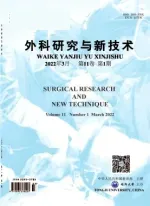Hidden blood loss after intertrochanteric fractures in elderly patients and its influence on the postoperative function recovery:a random controlled trial
2011-08-15李海东LiHaidongDeptOrthopXinhuaHospSchoolMedShanghaiJiaotongUnivShanghai200092ChinOrthopTrauma201113125129
李海东(Li Haidong,Dept Orthop,Xinhua Hosp,School Med,Shanghai Jiaotong Univ,Shanghai 200092)…∥Chin J Orthop Trauma.-2011,13(2).-125~129
Hidden blood loss after intertrochanteric fractures in elderly patients and its influence on the postoperative function recovery:a random controlled trial
李海东(Li Haidong,Dept Orthop,Xinhua Hosp,School Med,Shanghai Jiaotong Univ,Shanghai 200092)…∥Chin J Orthop Trauma.-2011,13(2).-125~129
ObjectiveTo investigate hidden blood loss after various types of intertrochanteric fractures and to determine whether oral iron supplementations is benefical for the postoperative functional recovery in elderly patients.MethodsFrom January 2007 to October 2009,300 elderly patients with intertrochanteric fracture were enrolled into the study after screening.They were randomized into a study group receiving oral iron supplementation for 6 weeks,and a control group receiving no anti-anemic intervention.All the patients were treated with closed reduction and intramedullary fixation.Hemoglobin levels were examined and functional recovery was evaluated using the functional independence measure(FIM)method and Harris scoring system preoperation,on 1,2 and 3 days postoperation,at discharge and follow ups of 1,2,3 and 6 months.ResultsA total of 79 patients were excluded because of preoperative or postoperative blood transfusion,loss to follow-up,or major complications.The remaining 114 patients in the study group and 107 ones in the control group were finally analyzed.There were no significant differences in mean perioperative visible blood loss(34.4 mL versus 34.5 mL,P >0.05)between the 2 groups.Hemoglobin levels declined dramatically in the first 3 days postoperatively as compared with the preoperative values,but no difference in the declined hemoglobin levels was found among different AO frac-ture types(P >0.05).Significant differences in the increase of hemoglobin levels were found at the follow-ups of 1,2 and 3 months between patients who received iron therapy and those who did not(P < 0.05),but no difference were found at the follow-up 6 months(P >0.05).Similary,the increased FIM scores at the follow-ups of 1,2 and 3 months were significantly higher in patients with iron therapy than in those without(P <0.05),but no difference was found at the follow-up of 6 months(P>0.05).No significant difference in the Harris scores was found at any time between the 2 groups(P >0.05).ConclusionAO classification is not an independent predictor of the hidden blood loss after intertrochanteric fractures.Oral iron supplementation can effectively correct postoperative anemia and accelerate functional recovery in elderly patients.13 refs,1 fig,5 tabs.
(Authors)
猜你喜欢
杂志排行
外科研究与新技术的其它文章
- Treatment for 63 cases of the elderly with choledocholith by duodenoscope
- Meta-analysis of the Resolution rate of Type 2 diabetes mellitus in patients undergoing Roux-en-Y gastric bypass surgery
- Quantification of spatial expansion of cervical tumours using Magnetic Resonance Imaging
- Effect of the tumescent infiltration solution temperature on body temperature
- Histologic analysis and long-term effect of acellular dermal matrix combined with autologous thin split-thickness skin graft
- Experimental study of the effect of adipose stromal vascular fraction cells on the survival rate of fat transplnio
